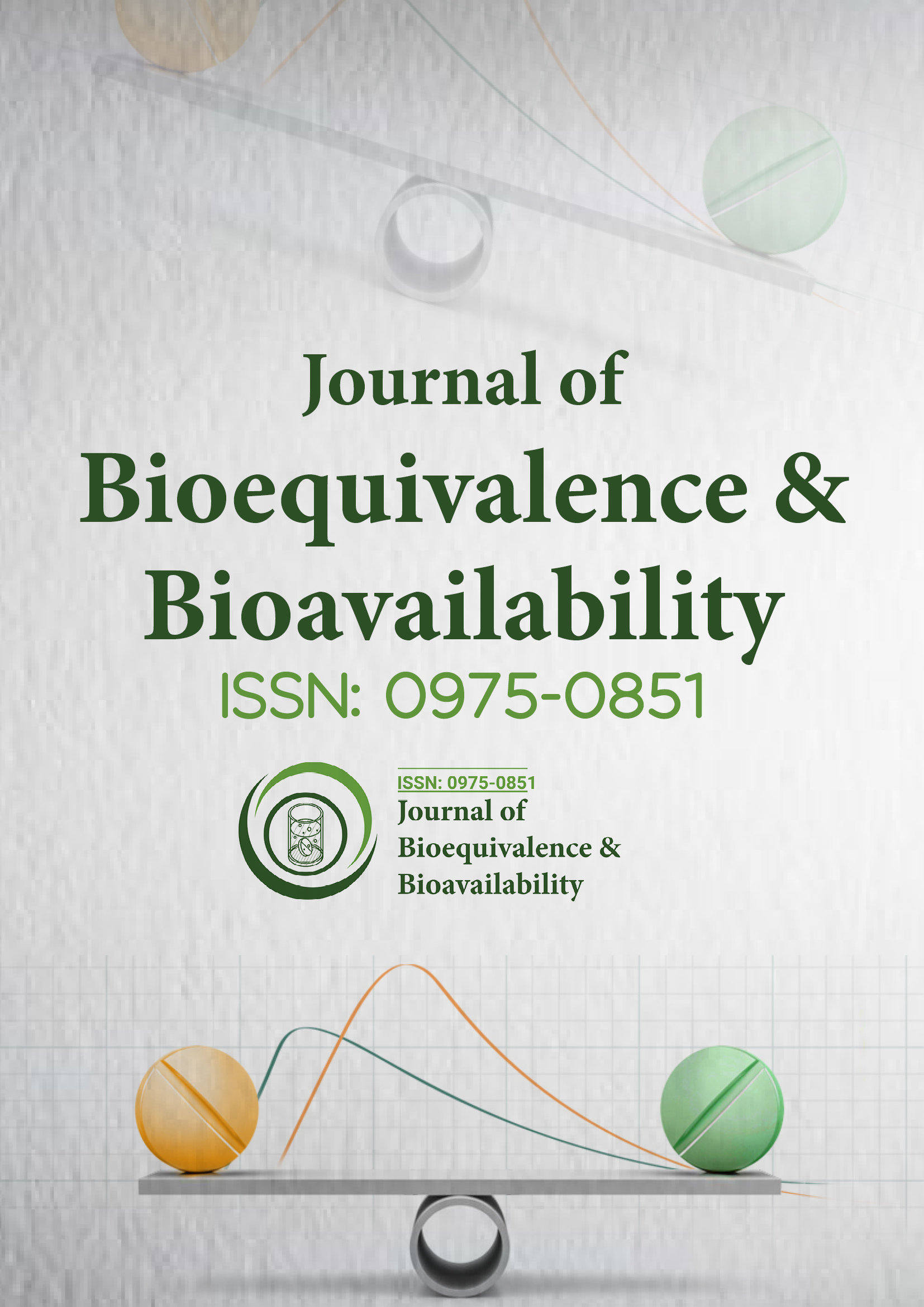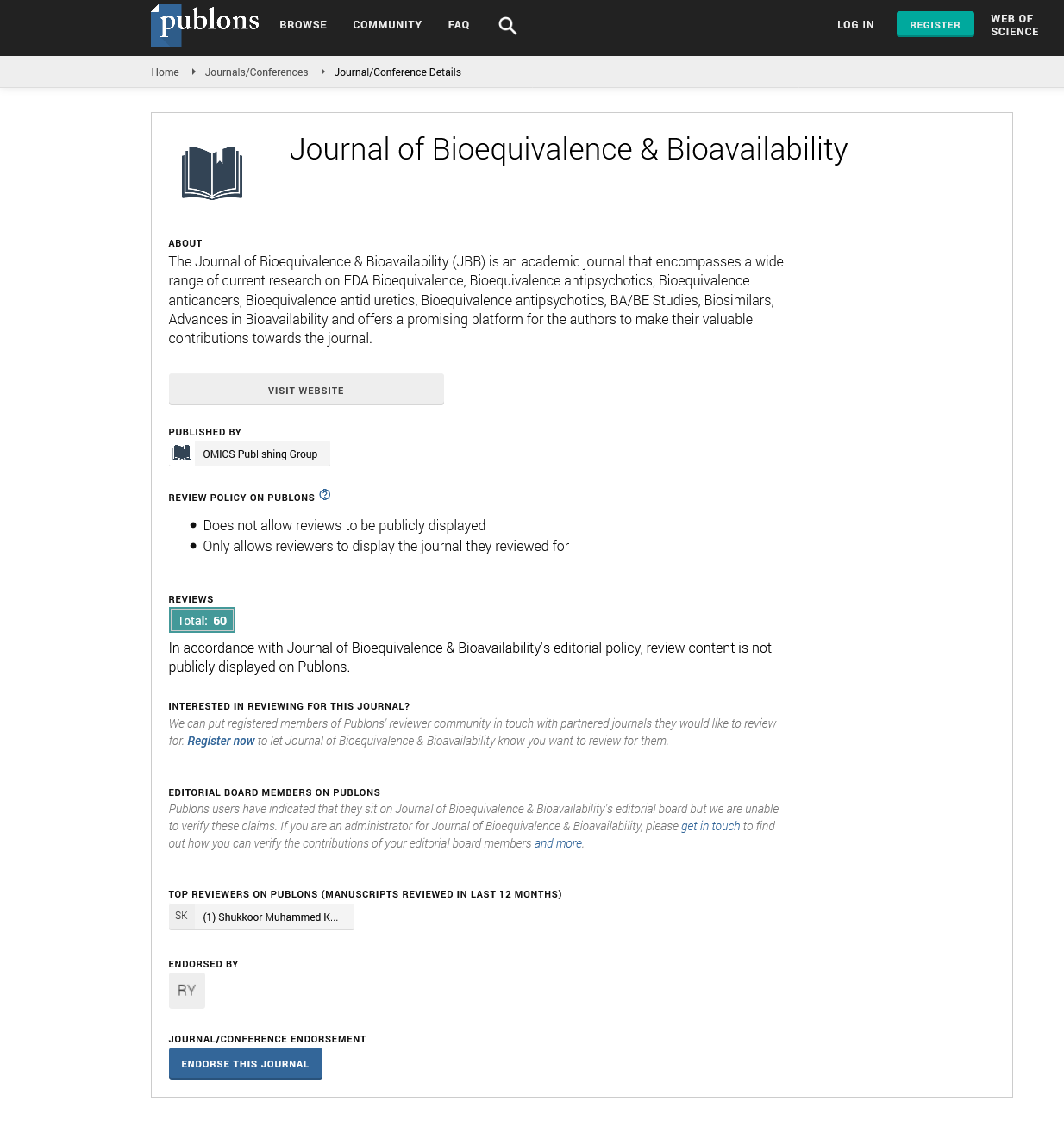Indexed In
- Academic Journals Database
- Open J Gate
- Genamics JournalSeek
- Academic Keys
- JournalTOCs
- China National Knowledge Infrastructure (CNKI)
- CiteFactor
- Scimago
- Ulrich's Periodicals Directory
- Electronic Journals Library
- RefSeek
- Hamdard University
- EBSCO A-Z
- OCLC- WorldCat
- SWB online catalog
- Virtual Library of Biology (vifabio)
- Publons
- MIAR
- University Grants Commission
- Geneva Foundation for Medical Education and Research
- Euro Pub
- Google Scholar
Useful Links
Share This Page
Journal Flyer

Open Access Journals
- Agri and Aquaculture
- Biochemistry
- Bioinformatics & Systems Biology
- Business & Management
- Chemistry
- Clinical Sciences
- Engineering
- Food & Nutrition
- General Science
- Genetics & Molecular Biology
- Immunology & Microbiology
- Medical Sciences
- Neuroscience & Psychology
- Nursing & Health Care
- Pharmaceutical Sciences
Perspective - (2025) Volume 17, Issue 1
Comparative Evaluation of Drug Absorption Metrics in Fasting and Fed Bioequivalence Studies
Sarah Ben*Received: 03-Feb-2025, Manuscript No. JBB-24-28936; Editor assigned: 05-Feb-2025, Pre QC No. JBB-24-28936 (PQ); Reviewed: 18-Feb-2025, QC No. JBB-24-28936; Revised: 25-Feb-2025, Manuscript No. JBB-24-28936 (R); Published: 04-Mar-2025, DOI: 10.35248/0975-0851.25.17.617
Description
Drug absorption metrics serve as foundational tools in assessing bioequivalence, particularly for the development and regulatory evaluation of generic drug products. Understanding and quantifying how a drug is absorbed into the systemic circulation is essential for ensuring that the generic formulation delivers the same therapeutic benefits as the reference listed drug. Drug absorption is a complex process influenced by multiple factors, including the physicochemical properties of the drug, formulation characteristics, gastrointestinal physiology, and the presence of food or other co-administered drugs. In the context of bioequivalence studies, key pharmacokinetic parameters act as surrogate indicators of drug absorption, guiding the determination of therapeutic equivalence without the need for extensive clinical endpoint trials.
The most commonly evaluated metrics of drug absorption in bioequivalence studies are the maximum plasma concentration, the time to reach this Maximum Concentration (tmax), and the Area Under the plasma concentration-time Curve (AUC). Among these, AUC is particularly significant as it reflects the total extent of drug absorption. Cmax provides insight into the peak exposure of the drug in systemic circulation and, by extension, its potential for pharmacological effect and toxicity. tmax, while not a primary parameter in regulatory evaluations, offers useful information about the rate of absorption and can indicate whether a formulation delivers the drug too rapidly or too slowly. These parameters are derived from well-designed pharmacokinetic studies, typically conducted under both fasting and fed conditions to account for variable physiological states.
The assessment of drug absorption in special populations poses additional considerations. In pediatrics, differences in gastrointestinal pH, enzyme expression, and transit time can significantly affect drug absorption. Similarly, in the elderly, changes in gastrointestinal function and co-morbid conditions may alter the pharmacokinetic profile. These physiological differences necessitate careful interpretation of absorption metrics and, in some cases, the design of tailored bioequivalence studies. Regulatory agencies are increasingly recognizing the need for population-specific evaluations, and absorption metrics must be contextualized within the physiological framework of the target demographic.
Another critical aspect is the impact of food on drug absorption, which can significantly alter Cmax and AUC values. A high-fat meal, for example, may enhance or reduce the absorption of certain drugs by affecting solubility, gastrointestinal motility, or metabolism. Accordingly, regulatory guidance often requires both fasting and fed bioequivalence studies to ensure consistent absorption under varied physiological conditions. The analysis of food effect involves comparing absorption metrics across nutritional states and must be interpreted carefully to ascertain clinical relevance.
With the growing interest in personalized medicine and digital health technologies, the landscape of drug absorption metrics is poised for transformation. Wearable biosensors and smart drug delivery systems may one day enable real-time monitoring of drug absorption, providing individualized pharmacokinetic data for bioequivalence and beyond. Moreover, machine learning algorithms are being explored to predict absorption metrics based on molecular properties, formulation data, and patient characteristics. Such innovations could streamline bioequivalence assessments, optimize formulation development, and ultimately improve therapeutic outcomes.
In the regulatory environment, there is a continuous effort to refine and harmonize the evaluation of drug absorption metrics. The International Council for Harmonisation of Technical Requirements for Pharmaceuticals for Human Use and regional agencies are working towards greater consistency in the definition, calculation, and interpretation of these metrics. Emerging guidances are incorporating novel approaches such as model-integrated evidence and real-world pharmacokinetic data. These advancements reflect a broader recognition of the dynamic and multifaceted nature of drug absorption, and the need for adaptable and science-based regulatory frameworks.
In conclusion, drug absorption metrics form the backbone of bioequivalence evaluations for generic drug products. By quantifying the rate and extent of drug entry into the systemic circulation, these metrics ensure that patients receive safe and effective alternatives to branded medications. From the standard measures of Cmax and AUC to more specialized parameters like partial AUCs and IVIVC-based predictions, the science of absorption continues to evolve in response to advances in technology, formulation complexity, and regulatory expectations. As the pharmaceutical landscape becomes increasingly sophisticated, the importance of robust, reliable, and context-specific absorption metrics will only grow, shaping the future of generic drug development and approval worldwide.
Citation: Ben S (2025). Comparative Evaluation of Drug Absorption Metrics in Fasting and Fed Bioequivalence Studies. J Bioequiv Availab. 17:617.
Copyright: © 2025 Ben S. This is an open-access article distributed under the terms of the Creative Commons Attribution License, which permits unrestricted use, distribution, and reproduction in any medium, provided the original author and source are credited.

